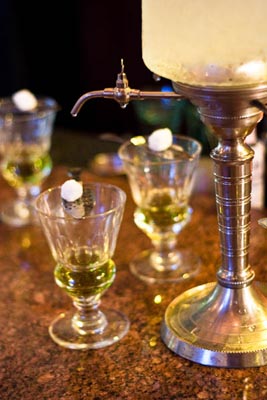I hate licorice. There, I said it. You’d think I’d be totally into the strange black rope-like candy that is, against all aesthetic evidence, edible, but I’m not. I do, however, find that I enjoy food items with licorice-like flavors. Fennel, for instance, is lovely. Star anise is an excellent flavoring. And it turns out that if the variety’s right, I even enjoy absinthe (beyond the tiny dab I use in my Sazaracs).

What do people know about absinthe? It is of questionable legality here in the States (or at least, it had been), and is considered to have hallucinogenic effects on those who imbibe (Green Fairy, anyone?). Typically, when I hear the word absinthe, Bohemian fairy tales (get it?) of Toulouse-Lautrec and Rimbaud dance through my head (maybe with a sprinkling of cynical Oscar Wilde for good measure) achieving artistic greatness thanks in part to the wormwood-induced visions that befell them after a night of boozing. Turns out, the amount of wormwood infusion you’d have to consume to realize any actual effect would almost certainly be overshadowed by alcohol poisoning.

Over two months ago now, we had the opportunity, via one of Addie’s Eat-ups, to attend an absinthe tasting at Peche here in Austin. For those of you who remember where Malaga used to be, that’s where Peche is now. The aesthetic is beautiful – the perfect atmosphere, really, to enjoy a libation with such an interesting reputation.

The first absinthe we were able to try was Pernod. It had all the big, bold, licorice-like flavor that I was rather hoping to avoid. It was acceptable to drink, but nothing I’d personally ever crave. On the other hand, we were also offered a taste of Saint George, an American absinthe. I really enjoyed this one. The fennel-anise flavor was still there, but it was beautifully rounded out by flavors that I would have called floral. The aroma in particular was incredible. I would definitely spring for the Saint George again.

This is probably a little sad to say, but the serving method may have been my favorite part of our whole absinthe experience. Lined up along Peche’s bar were several absinthe fountains. Here’s how it works: The absinthe is placed into glasses and the glasses are topped by sugar cubes resting on lovely absinthe spoons. Then ice-cold water is slowly trickled from the fountains over the sugar and into the glasses holding the absinthe. The clear, grassy-green absinthe turns cloudy as the cold water trickles in. Evidently, this milkiness is called “louche” (which becomes relevant when you’re shopping the absinthe menu and trying to decide whether you want one that is light louche or strong louche).

Graham Wasilition was there to discuss absinthe in relation to his own brand, Tenneyson Absinthe Royale. Unfortunately, while I studiously sat at one of the front tables, I heard very little of the discussion. (For actual information, check out Boots’ account here.) I am now, however, quite excited to try out the Tenneyson once it’s available. Hopefully soon we’ll all be able to try Texas’ first absinthe for ourselves.